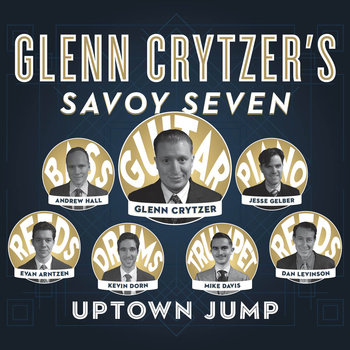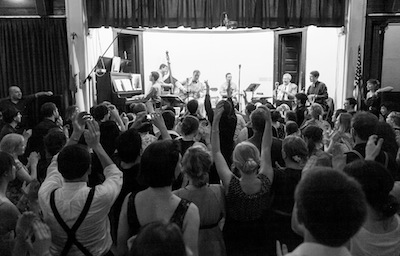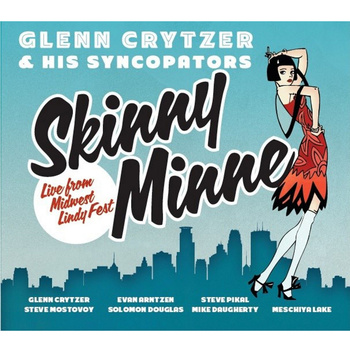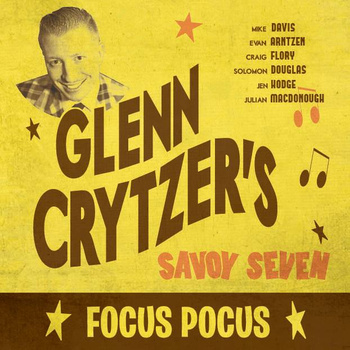Hello!
This is a post about music!
I was approached by Glenn Crytzer a couple of weeks months ago, saying “I’d love to have you do a piece on our new record. Please let me know if that’s something you’d be interested in. Here’s a digital copy of the album for you.”
And there was a digital copy of the album Uptown Jump by Glenn Crytzer’s Savoy Seven.
My review in brief:
Buy this album because it’s good, and it’s only $15. Buy it because you want to tell the band you support what they’re doing and you want them to keep doing it. You want dancers to hear this music and then demand organisers have them play their events. We need this stuff. I know I’d hire them in a heartbeat.
But
the sound quality is not ok for DJing, unless you are a rockstar DJ at a professionally run event, or just plain lucky enough to have a great local DJing sound set up. If you’re listening at home for pleasure, then fuck all that shit about sound quality and just buy it and LISTEN to it.
My review in extreme length:
As you probably know, this latest Crytzer project was funded by a kickstarter, and I have no idea whether I supported it or not. I’m usually quite happy to buy an album after it’s come out. More importantly, I will almost definitely buy an album if it’s on sale at a band gig. Which is the problem with Crytzer’s bands: they’re only playing in America (and maybe Canada?), which is far away, and not on my ‘to-travel’ list any time soon (soz america). I am all about Korea, as you know. So I will have to enjoy this band in recorded form.
This is important, because Crytzer is a dancer (or was – I dunno if he has time to dance these days, what with all the touring and recovering) and plays all the big American dance events. This is a dancer’s band, playing dance music for dancers. I’ve spoken about one particular gig in detail before. His first release, by Crytzer’s Blue Rhythm Band, Chasin’ the Blues, was popular with dancers, the band’s name an obvious nod to DJ and dancing nerds. But it was the second album Harlem Mad by Glenn Crytzer and His Syncopators that was wildly popular, DJed by people all over the place. Including me. I still hear people DJing ‘Fortunate Love’ with Meschiya Lake on vocals.
I think this 2011 recording, combined with the popular live shows, and the presence of the massively popular Meschiya Lake, really was the perfect storm, dropping at just the right time. Lake and all things NOLA were supercrazy popular (and some of us had begun to wail about the lack of big band action at events and in DJ sets), and squishing this charismatic performer into the line up was genius. The music itself managed to combine the rough edges and ‘real’ sound of NOLA with the larger band format and more complex arrangements of a bigger band.
After that, there was Skinne Minne by Glenn Crytzer and his Syncopators in 2011. This album used what many dancers would describe as an ‘authentic’ recording sound. Simply put, it sounds like an olden days recording. And I will be very blunt here: it was unDJable. This is a terrible shame, because it was recorded live at Lindy Fest, and the songs are just great. It feels exciting and fun. There are a couple of musical rough spots, but who cares – it FEELS LIKE LINDY HOP! But I have only DJed from it perhaps once or twice, ever. Because I tend to DJ in shitty halls with shitty sound gear, and if I’m going to take a risk on a ‘poor quality’ recording, I’ll go with Ellington or Basie or Hamp.
In fact, my experience with this album was so disappointing, I didn’t even buy the next album, Focus Pocus by the Savoy Seven, and featuring all original compositions. Listening to it right now, I feel like a total fool. This has a more conventionally ‘modern’ recording sound, but definitely still feels ‘old’. In fact, I’m buying it now. And you should too, because it’s only $7. Crazy.
It’s worth mentioning the christmas album A Little Love this Christmas, because lindy DJs are often looking for christmas themed music, and Glenn has gone and made some that’s actually good. Buy this too.
Ok, so what does all this have to do with the new album? I think it’s important, because Crytzer is now a well-known name and band in the lindy hop scene, particularly on the more competitive big American event circuit. DJs and dancers aren’t as likely to cut him some slack now. The ‘authentic’ earlier swing sound is a bit more common, and we are pickier. We are less likely to tolerate poor quality recordings.
This is, of course, the first thing I noticed about the new album Uptown Jump. It uses an ‘old style’ recording technology. And I did groan. No matter how great the songs are, they’re going to be up against all those old masters again. It isn’t fair, it’s uncool, it’s even ungrateful to think like that. But this is the bottom line for a swing DJ: it has to sound good on a sound system in a crowded or empty room. And every modern band is competing with a mythic ‘golden age’ of swing.
Listening to it over the following couple of weeks and talking about it with my DJing friends, the general consensus was: great album, unworkable sound ‘quality’. It’s very unfair, because this is an album of original compositions that are actually quite good. These days when I hear a band introduce an ‘original’, I cringe a little. There’s some really bad shit out there. But the actual songs on this are pretty bloody good. They are properly in keeping with musical history (for the most part), they swing, they make great dancing. I just can’t hear them properly! ARGH!
As a friend said, I wish I could have a copy of ‘clean’ master. I’d DJ the shit out of that.
Even the album itself – the song order – is perfect for dancers. Good range of tempos, good range of styles and feels.
The musicians are all great too:
Mike Davis, tpt
Evan Arntzen, cl/ts
Dan Levinson, ss/as/ts
Jesse Gelber, pno
Glenn Crytzer, g/vcl/ldr
Andrew Hall, sb
Kevin Dorn, d
It’s a 7 piece – not too big, not too little – and there are musical moments that make me squee. Everything is here, but I can’t hear it!
Of course, I do have severely fucked up hearing from all these years DJing and dancing. And I am a picky DJ. Who has to play on some of the worst sound gear and in some of the worst rooms ever. I’m no pampered ILHC DJ, that’s for sure :D .
But I’m also a DJ who collects and plays a lot of modern bands, so I’ve heard a lot of different modern recording set ups. Some have sucked big time (there was one Tuba Skinny album that was pretty darn bad. But when I listen to something like the latest Tuba Skinny album Pyramid Strut, with a lovely, lovely warm studio sound – each instrument right THERE in the room – and that really nice, energetic street jazz musician camaraderie… I get sad about this Crytzer recording.
:(
But let’s talk about authenticity. That is the point of Glenn’s approach to the production process. Dude had a VISION, and we need to engage with that. Glenn responded to a fairly lively discussion about the new album on facebook with this great post Low-fi.
I like that he begins with the term ‘lo-fi’. Because fidelity is, of course, the idea of ‘trueness’ or faithfulness to truth, honesty, exactness of a copy, realness. This is what we are all about with recreation in lindy hop: we are looking for ‘realness’. Authenticity. We value ‘realness’ in so many ways in the lindy hop scene, from historically accurate choreography to bringing ‘real’ feels in a dance competition (the argument about improvisation vs choreography following Lindy Focus is an example of this). The key tension seems to be between recreating music/dance/art in minute detail and accuracy, and tempering that with recreating the intentions of the original artists. So we may recreate the lindy hop routine in Hellzapoppin’ to pinpoint accuracy, but miss the point that these guys valued making shit up – invention and improvisation
I have written about recreationism in the lindy hop scene approximately one million times, most recently about DJing in Herrang, land of recreationist obsession. There are good things about being an obsessive recreationist, and there are bad things. And there are interesting things that are worth talking about.
So let’s accept the premise of Glenn’s project: this is recreationism. Let’s engage with the album on those terms, lets talk about those interesting things.
One of the things I like about this album is that it’s a smaller band. I am a massive fan of Ellington’s small groups, the Goodman/Hamp small groups, John Kirby’s groups… and so on. I really like the way a small group – in the swing era, peopled by musicians who also played in big bands – allowed a band to explore more complex, more ‘modern’ arrangements and vibes. A lot of the guys in these groups went on to do bop and modern music. And each band allowed each musician a unique style and real role in the band.
Listening to Crytzer’s band, it definitely sounds like a swing era small group. Sometimes to the point of… um… homage? Take the song ‘Road to Tallahassee’. It sounds very similar to the Ellington small group recording of ‘Ain’t the Gravy Good’ (credited to Cootie Williams and his Rugcutters). Cootie’s an interesting example, because he had such a distinct sound, and Ellington’s band played arrangements that were developed just for Cootie, with parts that showcased his style.
This seems the point of this recording by the Savoy Seven, though. To do homage to these groups. And that’s what they do. There’s nothing wrong with that – we dig it! But there are moments on this album, though, where I feel they don’t give enough love and attention to developing their own sound.
Let’s have a look at something Glenn says in that tumblr post about the recording process for this album:
The modern “standard” way to record an album these days is to put mics very close to every instrument to isolate their sound. In fact sometimes the instruments are even put into separate rooms with the musicians listening to each other through headphones to create total isolation. Using this technique everyone doesn’t even have to play at the same time!
….This creates the sound we’re all used to in the 21st century – the sound of rock and pop music. It’s very bright, the instruments each sound very clearly like themselves and are isolated from each other, the sound can push the speakers really hard because the signal is super intense.
…
There were also some technologies that were available but were not used – by the 1940s the technology existed to put a mic on every instrument in the studio – but they chose to still use just a couple of mics – to let the sounds blend and then to record that. To me, that’s a cue that the natural blending and balancing of sounds was really important to band leaders. (link)
I like this point. I really like this idea of the importance of recording musicians who are all playing together in one room. It gets closer to capturing that sense of group is so central to jazz music, to improvised music!
I’m not sure this album as a whole is quite there. I don’t think the actual relationships between the instruments in each song are quite right. There’s something about the to-and-fro of musicians in Goodman’s small group that is unique. Their ways of taking turns, replying to each other, and interacting, reflect the dynamics and personality of the group. Goodman is the boss, but you hear him say “Ok, bring your shit. Let’s ignore all this segregation shit. You are GOOD, I am GOOD, let’s make the best fucking music ever.” And they all step up. You hear their personalities in their style and way of interacting to each other.
In Crytzer’s band, I hear people ‘taking turns’, having their say, rather than having a living conversation. A living conversation can involve interruption, call-and-response and collaborative meaning making. It doesn’t have to be this mannered, overly polite formal turn taking.
Do we have to sacrifice the clarity of sound to get that feeling of togetherness? Of course not. Nor do we have to push for that super-bright, ‘harsh’ sound that Glenn finds a bit much (and which I also find a bit much). The Tuba Skinny Pyramid Strut album is a good example of a modern recording that has real depth and warmth, but still manages sharp lightness when it needs to.
Does a modern recording have to have that particular recorded sound to be authentic? Here let’s look at a band that is almost ridiculously hardcore in their attention to historical detail. The Hot Jazz Alliance, recording their forthcoming album:
Milenberg Joys – The Hot Jazz Alliance The ‘Hot Jazz Alliance’ recording their debut album at ‘HiHat Studios’, April 2014. Michael McQuaid – clarinet, Jason Downes – alto sax, Andy Schumm – cornet, Josh Duffee – drums, John Scurry – banjo, Leigh Barker – string bass.
Sounds old, but isn’t. Different style of jazz to Glenn’s album, but I think my point is clear: it’s a pleasure to hear old music with that clarity of sound brought by modern technology. But we’ll wait and see what their recording is like.
Let me just finish off with a bit of attention to the songs themselves. Do they carry that same commitment to ‘old’ – recreationism? Is Glenn’s band pulling off this grand project?
I’m going to start with the song ‘Smokin’ that Weed’.
Songs about vipers, chasing the gong, and plain old garden variety tea are a dime a dozen in the jazz world. They don’t call them jazz cigarettes for nothing. But this one… hm. The lyrics are just too obvious, and it leaves the song feeling kind of juvenile. Sure, there were some dumb, obvious songs written in ye olden days about drugs. And sex. And food. But many of the songs about dope from the swing era (particularly for mass release) could be very clever, hiding their drug references in innuendo, metaphor and word play. Part of the pleasure of these songs is getting away with something naughty. so ‘Smokin’ that Weed’ could have been a bit…cleverer? Subtler?
I also find the lyrics of ‘Smokin’ that Weed’ and their delivery a bit too… intense. Which conflicts with the vibe of ‘floatin’ in the sky’. The accenting and pacing of the first lines is uncomfortable, and the emphasis on “suckin'” is too harsh and sharp:
Do you like the vipe
suckin’ on that pipe,
it gets ya feeling tight
aw smokin’ that weed
This song has real potential. The first, brassy notes remind me a lot of Herb Morand and the Harlem Hamfats, who of course recorded ‘If You’se a Viper’, a song that’s been very popular with American dancers over the years. This is a clever touchstone for Crytzer’s band. The Hamfats have jazzcred, being relatively obscure and yet still featuring a few very good musicians (like Buster Bailey, Rosetta Howard, Alberta Smith, etc). But the vocals in ‘Smokin’ that Weed’ aren’t right. If you listen to someone like Rosetta Howard singing ‘If Youse a Viper’, her pronounciation is mellow and relaxed, just as it should be if you’re chilling with a spliff.
But in ‘Smokin’ that Weed’, they’re rushing to get the joke out, and it feels a bit forced and eager to me. Not quite cool enough. More to the point, I’m not sure what the joke is, exactly. They’re basically just giggling about singing a song about smoking weed.
Sigh.
I guess what I’m saying is that this song lacks subtlety and nuance. Which I think is my quibble with a lot of the songs on this album, and with the general recreationist vibe. It’s not subtle. I need a little more nuance to really dig this. And it needs a little more sophistication to pass as properly ‘authentic’ in both tone and content.
What about the other songs? My favourite song is ‘Glenn’s Idea‘, because I like the piano in there. It reminds me very of all those nice small swing era groups. I’d certainly play ‘Savoy Special‘ for dancers, because it comes in strong and exciting and continues that way. ‘Missouri Loves Company‘ is definitely my sort of song, and I love it. To be honest, I’m a girl for instrumentals. Unless you’re the Hot Club of Cowtown and you have a voice like Whit Smith‘s on hand.
So, in sum, as I said up there at the beginning, buy this. It’s worth it. The musicians are good, it’s great dance music, it’s all good. But I’m disappointed by the sound ‘quality’, and I can’t DJ it at my regular gigs. :(





